Mental Health Assessment and the Mental Health Act: Week 2 Report
VerifiedAdded on 2022/09/06
|31
|7937
|13
Report
AI Summary
This report provides a comprehensive overview of mental health assessment, the Mental Health Act (Victoria, 2014), and risk assessment within the context of mental health nursing. It begins by defining the intended learning outcomes, emphasizing the role of nurses in assessment, the use of the Mental Health Act, and the importance of developing nursing care plans based on assessments. The report clarifies the interchangeable terms of Mental State Assessment (MSA) and Mental State Examination (MSE), detailing the 11 domains of an MSE, including appearance, behavior, speech, mood, affect, thought form and content, perception, cognition, insight, and judgment. The report emphasizes the significance of documentation and the limitations of MSE. It also explores the concept of risk assessment, including different types of risks such as deliberate self-harm, harm to others, and accidental self-harm, as well as protective factors. The report highlights the importance of recognizing high-risk factors for suicide and the role of the MH Act in ensuring patient safety. It concludes with practical advice for working with suicidal clients and emphasizes the need for continuous professional development in mental health care.
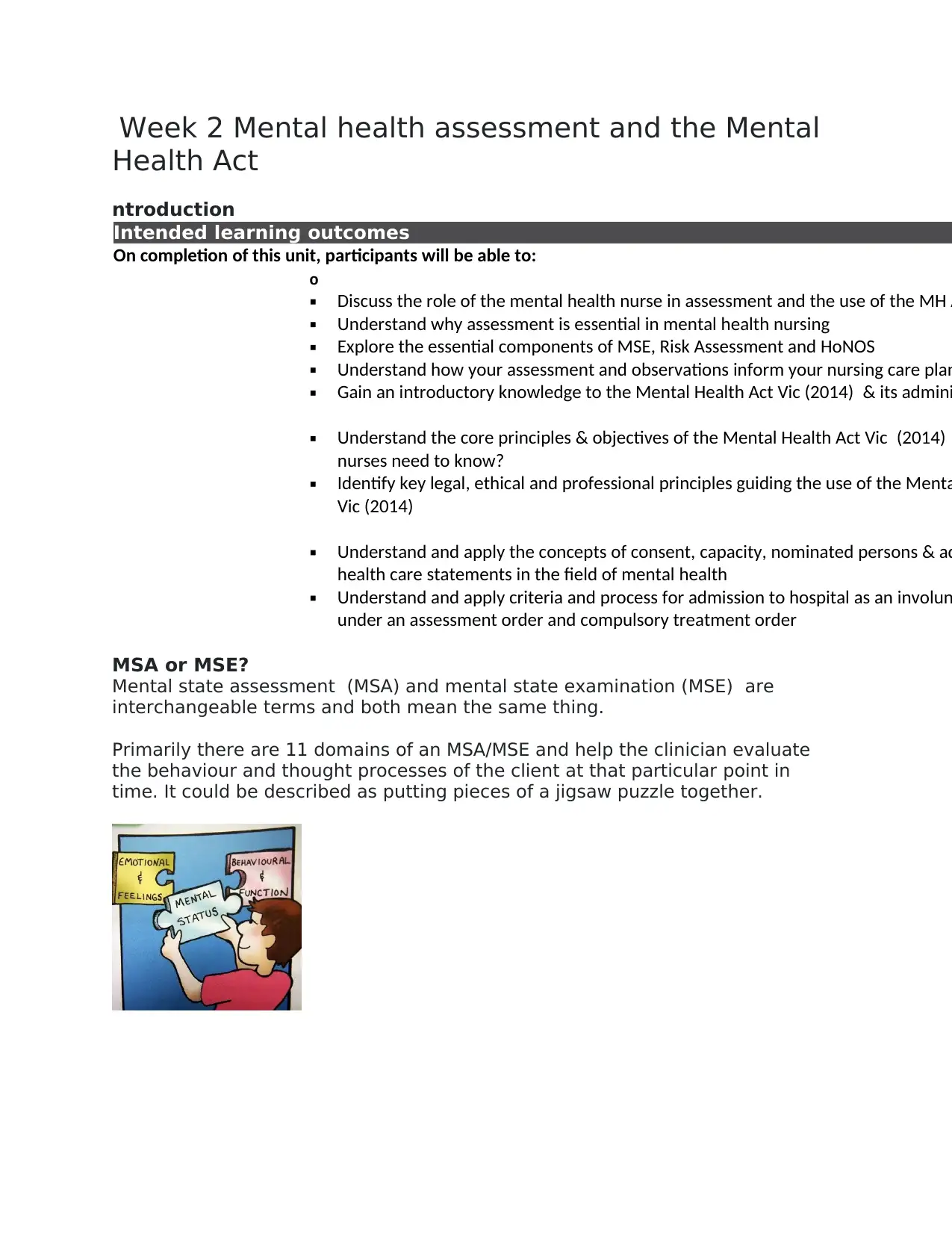
Week 2 Mental health assessment and the Mental
Health Act
ntroduction
Intended learning outcomes
On completion of this unit, participants will be able to:
o
Discuss the role of the mental health nurse in assessment and the use of the MH A
Understand why assessment is essential in mental health nursing
Explore the essential components of MSE, Risk Assessment and HoNOS
Understand how your assessment and observations inform your nursing care plan
Gain an introductory knowledge to the Mental Health Act Vic (2014) & its admini
Understand the core principles & objectives of the Mental Health Act Vic (2014)
nurses need to know?
Identify key legal, ethical and professional principles guiding the use of the Menta
Vic (2014)
Understand and apply the concepts of consent, capacity, nominated persons & ad
health care statements in the field of mental health
Understand and apply criteria and process for admission to hospital as an involun
under an assessment order and compulsory treatment order
MSA or MSE?
Mental state assessment (MSA) and mental state examination (MSE) are
interchangeable terms and both mean the same thing.
Primarily there are 11 domains of an MSA/MSE and help the clinician evaluate
the behaviour and thought processes of the client at that particular point in
time. It could be described as putting pieces of a jigsaw puzzle together.
Health Act
ntroduction
Intended learning outcomes
On completion of this unit, participants will be able to:
o
Discuss the role of the mental health nurse in assessment and the use of the MH A
Understand why assessment is essential in mental health nursing
Explore the essential components of MSE, Risk Assessment and HoNOS
Understand how your assessment and observations inform your nursing care plan
Gain an introductory knowledge to the Mental Health Act Vic (2014) & its admini
Understand the core principles & objectives of the Mental Health Act Vic (2014)
nurses need to know?
Identify key legal, ethical and professional principles guiding the use of the Menta
Vic (2014)
Understand and apply the concepts of consent, capacity, nominated persons & ad
health care statements in the field of mental health
Understand and apply criteria and process for admission to hospital as an involun
under an assessment order and compulsory treatment order
MSA or MSE?
Mental state assessment (MSA) and mental state examination (MSE) are
interchangeable terms and both mean the same thing.
Primarily there are 11 domains of an MSA/MSE and help the clinician evaluate
the behaviour and thought processes of the client at that particular point in
time. It could be described as putting pieces of a jigsaw puzzle together.
Paraphrase This Document
Need a fresh take? Get an instant paraphrase of this document with our AI Paraphraser
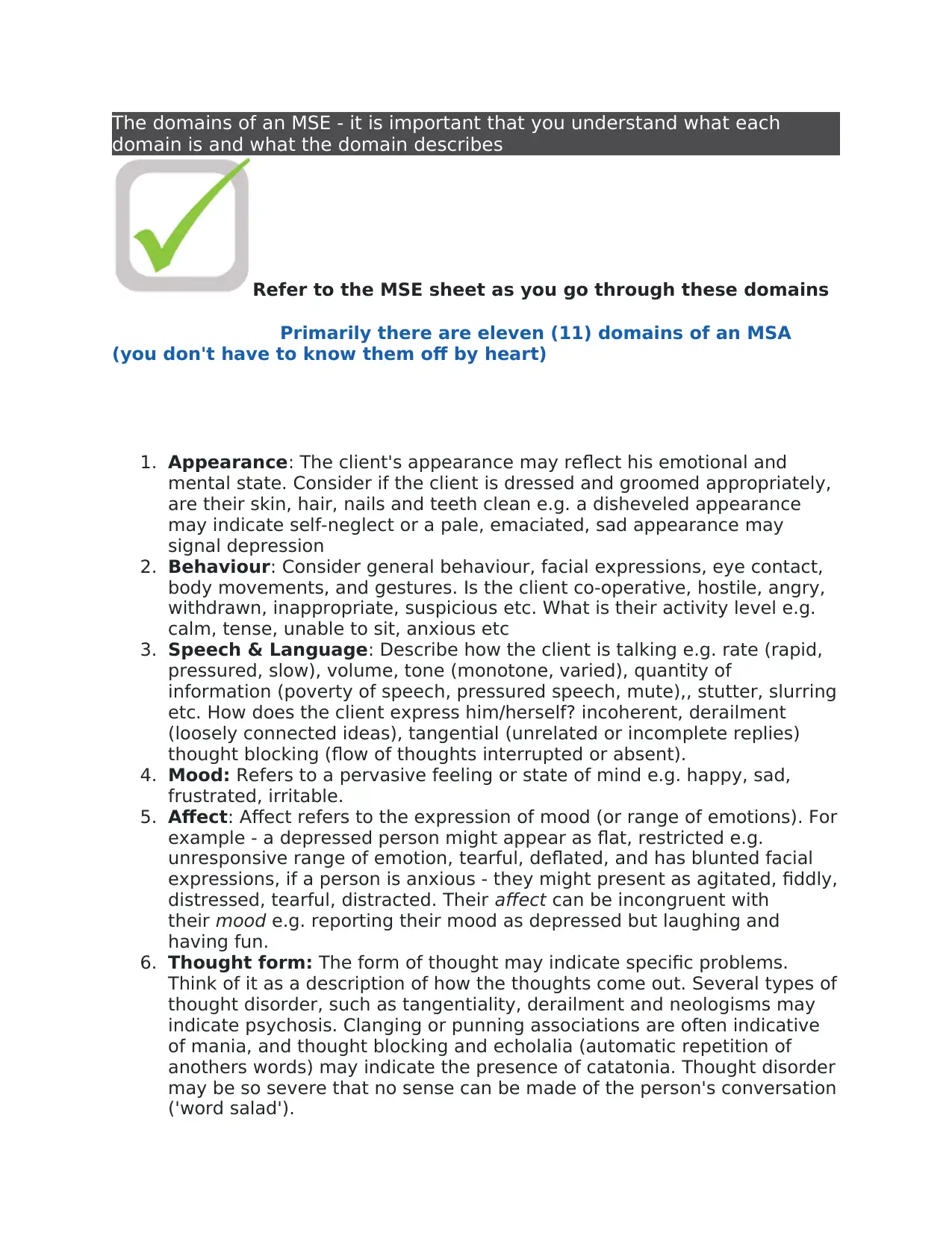
The domains of an MSE - it is important that you understand what each
domain is and what the domain describes
Refer to the MSE sheet as you go through these domains
Primarily there are eleven (11) domains of an MSA
(you don't have to know them off by heart)
1. Appearance: The client's appearance may reflect his emotional and
mental state. Consider if the client is dressed and groomed appropriately,
are their skin, hair, nails and teeth clean e.g. a disheveled appearance
may indicate self-neglect or a pale, emaciated, sad appearance may
signal depression
2. Behaviour: Consider general behaviour, facial expressions, eye contact,
body movements, and gestures. Is the client co-operative, hostile, angry,
withdrawn, inappropriate, suspicious etc. What is their activity level e.g.
calm, tense, unable to sit, anxious etc
3. Speech & Language: Describe how the client is talking e.g. rate (rapid,
pressured, slow), volume, tone (monotone, varied), quantity of
information (poverty of speech, pressured speech, mute),, stutter, slurring
etc. How does the client express him/herself? incoherent, derailment
(loosely connected ideas), tangential (unrelated or incomplete replies)
thought blocking (flow of thoughts interrupted or absent).
4. Mood: Refers to a pervasive feeling or state of mind e.g. happy, sad,
frustrated, irritable.
5. Affect: Affect refers to the expression of mood (or range of emotions). For
example - a depressed person might appear as flat, restricted e.g.
unresponsive range of emotion, tearful, deflated, and has blunted facial
expressions, if a person is anxious - they might present as agitated, fiddly,
distressed, tearful, distracted. Their affect can be incongruent with
their mood e.g. reporting their mood as depressed but laughing and
having fun.
6. Thought form: The form of thought may indicate specific problems.
Think of it as a description of how the thoughts come out. Several types of
thought disorder, such as tangentiality, derailment and neologisms may
indicate psychosis. Clanging or punning associations are often indicative
of mania, and thought blocking and echolalia (automatic repetition of
anothers words) may indicate the presence of catatonia. Thought disorder
may be so severe that no sense can be made of the person's conversation
('word salad').
domain is and what the domain describes
Refer to the MSE sheet as you go through these domains
Primarily there are eleven (11) domains of an MSA
(you don't have to know them off by heart)
1. Appearance: The client's appearance may reflect his emotional and
mental state. Consider if the client is dressed and groomed appropriately,
are their skin, hair, nails and teeth clean e.g. a disheveled appearance
may indicate self-neglect or a pale, emaciated, sad appearance may
signal depression
2. Behaviour: Consider general behaviour, facial expressions, eye contact,
body movements, and gestures. Is the client co-operative, hostile, angry,
withdrawn, inappropriate, suspicious etc. What is their activity level e.g.
calm, tense, unable to sit, anxious etc
3. Speech & Language: Describe how the client is talking e.g. rate (rapid,
pressured, slow), volume, tone (monotone, varied), quantity of
information (poverty of speech, pressured speech, mute),, stutter, slurring
etc. How does the client express him/herself? incoherent, derailment
(loosely connected ideas), tangential (unrelated or incomplete replies)
thought blocking (flow of thoughts interrupted or absent).
4. Mood: Refers to a pervasive feeling or state of mind e.g. happy, sad,
frustrated, irritable.
5. Affect: Affect refers to the expression of mood (or range of emotions). For
example - a depressed person might appear as flat, restricted e.g.
unresponsive range of emotion, tearful, deflated, and has blunted facial
expressions, if a person is anxious - they might present as agitated, fiddly,
distressed, tearful, distracted. Their affect can be incongruent with
their mood e.g. reporting their mood as depressed but laughing and
having fun.
6. Thought form: The form of thought may indicate specific problems.
Think of it as a description of how the thoughts come out. Several types of
thought disorder, such as tangentiality, derailment and neologisms may
indicate psychosis. Clanging or punning associations are often indicative
of mania, and thought blocking and echolalia (automatic repetition of
anothers words) may indicate the presence of catatonia. Thought disorder
may be so severe that no sense can be made of the person's conversation
('word salad').
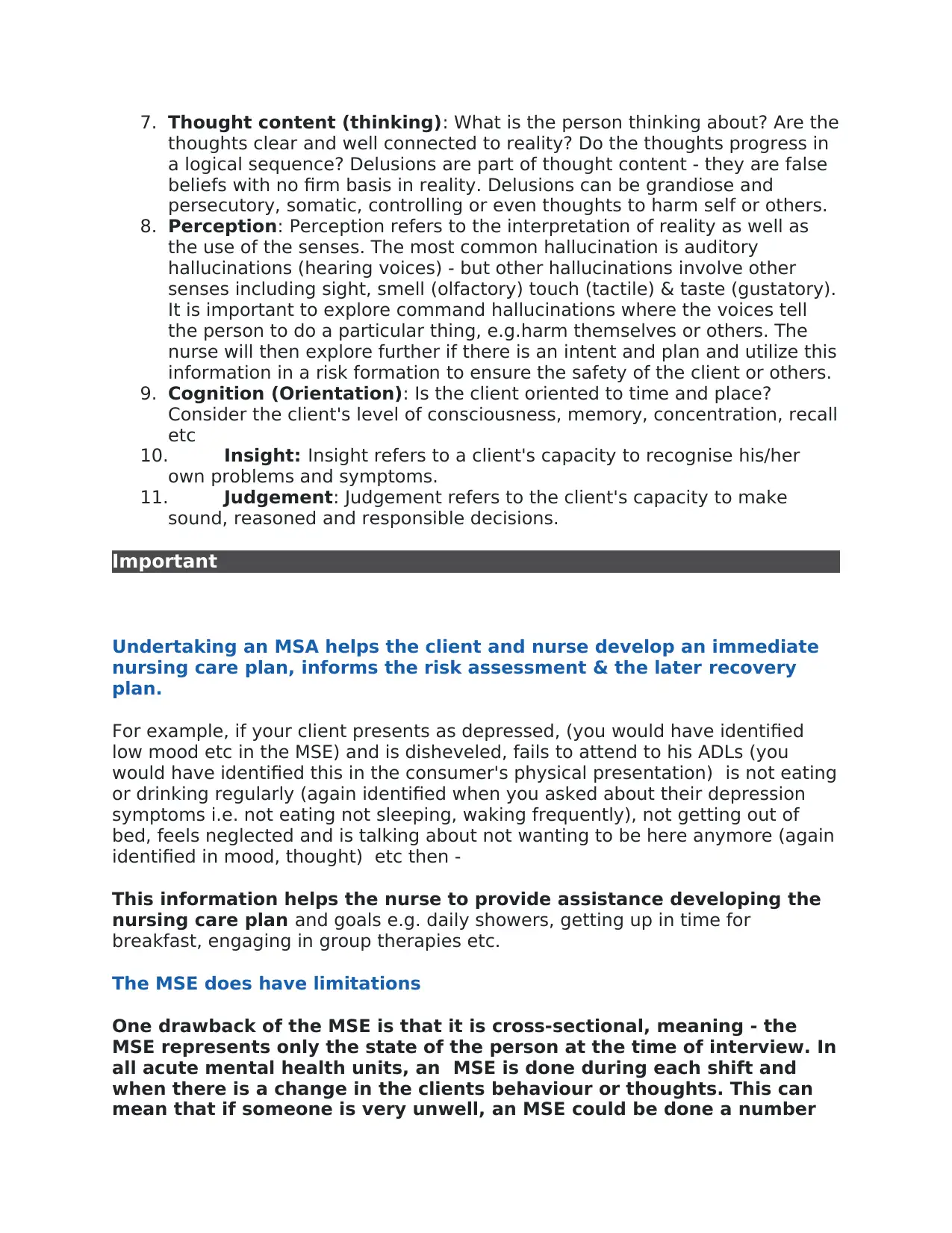
7. Thought content (thinking): What is the person thinking about? Are the
thoughts clear and well connected to reality? Do the thoughts progress in
a logical sequence? Delusions are part of thought content - they are false
beliefs with no firm basis in reality. Delusions can be grandiose and
persecutory, somatic, controlling or even thoughts to harm self or others.
8. Perception: Perception refers to the interpretation of reality as well as
the use of the senses. The most common hallucination is auditory
hallucinations (hearing voices) - but other hallucinations involve other
senses including sight, smell (olfactory) touch (tactile) & taste (gustatory).
It is important to explore command hallucinations where the voices tell
the person to do a particular thing, e.g.harm themselves or others. The
nurse will then explore further if there is an intent and plan and utilize this
information in a risk formation to ensure the safety of the client or others.
9. Cognition (Orientation): Is the client oriented to time and place?
Consider the client's level of consciousness, memory, concentration, recall
etc
10. Insight: Insight refers to a client's capacity to recognise his/her
own problems and symptoms.
11. Judgement: Judgement refers to the client's capacity to make
sound, reasoned and responsible decisions.
Important
Undertaking an MSA helps the client and nurse develop an immediate
nursing care plan, informs the risk assessment & the later recovery
plan.
For example, if your client presents as depressed, (you would have identified
low mood etc in the MSE) and is disheveled, fails to attend to his ADLs (you
would have identified this in the consumer's physical presentation) is not eating
or drinking regularly (again identified when you asked about their depression
symptoms i.e. not eating not sleeping, waking frequently), not getting out of
bed, feels neglected and is talking about not wanting to be here anymore (again
identified in mood, thought) etc then -
This information helps the nurse to provide assistance developing the
nursing care plan and goals e.g. daily showers, getting up in time for
breakfast, engaging in group therapies etc.
The MSE does have limitations
One drawback of the MSE is that it is cross-sectional, meaning - the
MSE represents only the state of the person at the time of interview. In
all acute mental health units, an MSE is done during each shift and
when there is a change in the clients behaviour or thoughts. This can
mean that if someone is very unwell, an MSE could be done a number
thoughts clear and well connected to reality? Do the thoughts progress in
a logical sequence? Delusions are part of thought content - they are false
beliefs with no firm basis in reality. Delusions can be grandiose and
persecutory, somatic, controlling or even thoughts to harm self or others.
8. Perception: Perception refers to the interpretation of reality as well as
the use of the senses. The most common hallucination is auditory
hallucinations (hearing voices) - but other hallucinations involve other
senses including sight, smell (olfactory) touch (tactile) & taste (gustatory).
It is important to explore command hallucinations where the voices tell
the person to do a particular thing, e.g.harm themselves or others. The
nurse will then explore further if there is an intent and plan and utilize this
information in a risk formation to ensure the safety of the client or others.
9. Cognition (Orientation): Is the client oriented to time and place?
Consider the client's level of consciousness, memory, concentration, recall
etc
10. Insight: Insight refers to a client's capacity to recognise his/her
own problems and symptoms.
11. Judgement: Judgement refers to the client's capacity to make
sound, reasoned and responsible decisions.
Important
Undertaking an MSA helps the client and nurse develop an immediate
nursing care plan, informs the risk assessment & the later recovery
plan.
For example, if your client presents as depressed, (you would have identified
low mood etc in the MSE) and is disheveled, fails to attend to his ADLs (you
would have identified this in the consumer's physical presentation) is not eating
or drinking regularly (again identified when you asked about their depression
symptoms i.e. not eating not sleeping, waking frequently), not getting out of
bed, feels neglected and is talking about not wanting to be here anymore (again
identified in mood, thought) etc then -
This information helps the nurse to provide assistance developing the
nursing care plan and goals e.g. daily showers, getting up in time for
breakfast, engaging in group therapies etc.
The MSE does have limitations
One drawback of the MSE is that it is cross-sectional, meaning - the
MSE represents only the state of the person at the time of interview. In
all acute mental health units, an MSE is done during each shift and
when there is a change in the clients behaviour or thoughts. This can
mean that if someone is very unwell, an MSE could be done a number
⊘ This is a preview!⊘
Do you want full access?
Subscribe today to unlock all pages.

Trusted by 1+ million students worldwide
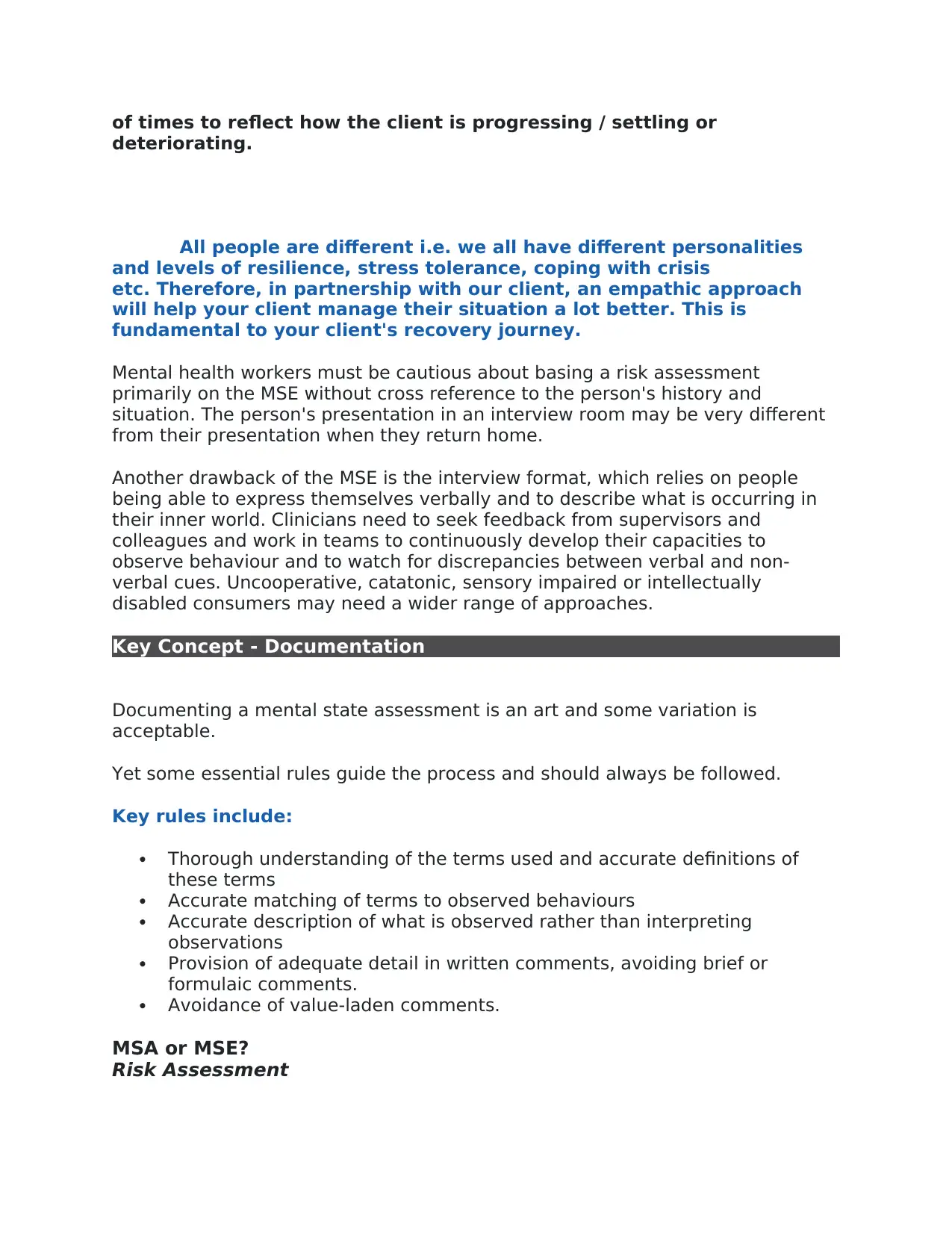
of times to reflect how the client is progressing / settling or
deteriorating.
All people are different i.e. we all have different personalities
and levels of resilience, stress tolerance, coping with crisis
etc. Therefore, in partnership with our client, an empathic approach
will help your client manage their situation a lot better. This is
fundamental to your client's recovery journey.
Mental health workers must be cautious about basing a risk assessment
primarily on the MSE without cross reference to the person's history and
situation. The person's presentation in an interview room may be very different
from their presentation when they return home.
Another drawback of the MSE is the interview format, which relies on people
being able to express themselves verbally and to describe what is occurring in
their inner world. Clinicians need to seek feedback from supervisors and
colleagues and work in teams to continuously develop their capacities to
observe behaviour and to watch for discrepancies between verbal and non-
verbal cues. Uncooperative, catatonic, sensory impaired or intellectually
disabled consumers may need a wider range of approaches.
Key Concept - Documentation
Documenting a mental state assessment is an art and some variation is
acceptable.
Yet some essential rules guide the process and should always be followed.
Key rules include:
Thorough understanding of the terms used and accurate definitions of
these terms
Accurate matching of terms to observed behaviours
Accurate description of what is observed rather than interpreting
observations
Provision of adequate detail in written comments, avoiding brief or
formulaic comments.
Avoidance of value-laden comments.
MSA or MSE?
Risk Assessment
deteriorating.
All people are different i.e. we all have different personalities
and levels of resilience, stress tolerance, coping with crisis
etc. Therefore, in partnership with our client, an empathic approach
will help your client manage their situation a lot better. This is
fundamental to your client's recovery journey.
Mental health workers must be cautious about basing a risk assessment
primarily on the MSE without cross reference to the person's history and
situation. The person's presentation in an interview room may be very different
from their presentation when they return home.
Another drawback of the MSE is the interview format, which relies on people
being able to express themselves verbally and to describe what is occurring in
their inner world. Clinicians need to seek feedback from supervisors and
colleagues and work in teams to continuously develop their capacities to
observe behaviour and to watch for discrepancies between verbal and non-
verbal cues. Uncooperative, catatonic, sensory impaired or intellectually
disabled consumers may need a wider range of approaches.
Key Concept - Documentation
Documenting a mental state assessment is an art and some variation is
acceptable.
Yet some essential rules guide the process and should always be followed.
Key rules include:
Thorough understanding of the terms used and accurate definitions of
these terms
Accurate matching of terms to observed behaviours
Accurate description of what is observed rather than interpreting
observations
Provision of adequate detail in written comments, avoiding brief or
formulaic comments.
Avoidance of value-laden comments.
MSA or MSE?
Risk Assessment
Paraphrase This Document
Need a fresh take? Get an instant paraphrase of this document with our AI Paraphraser
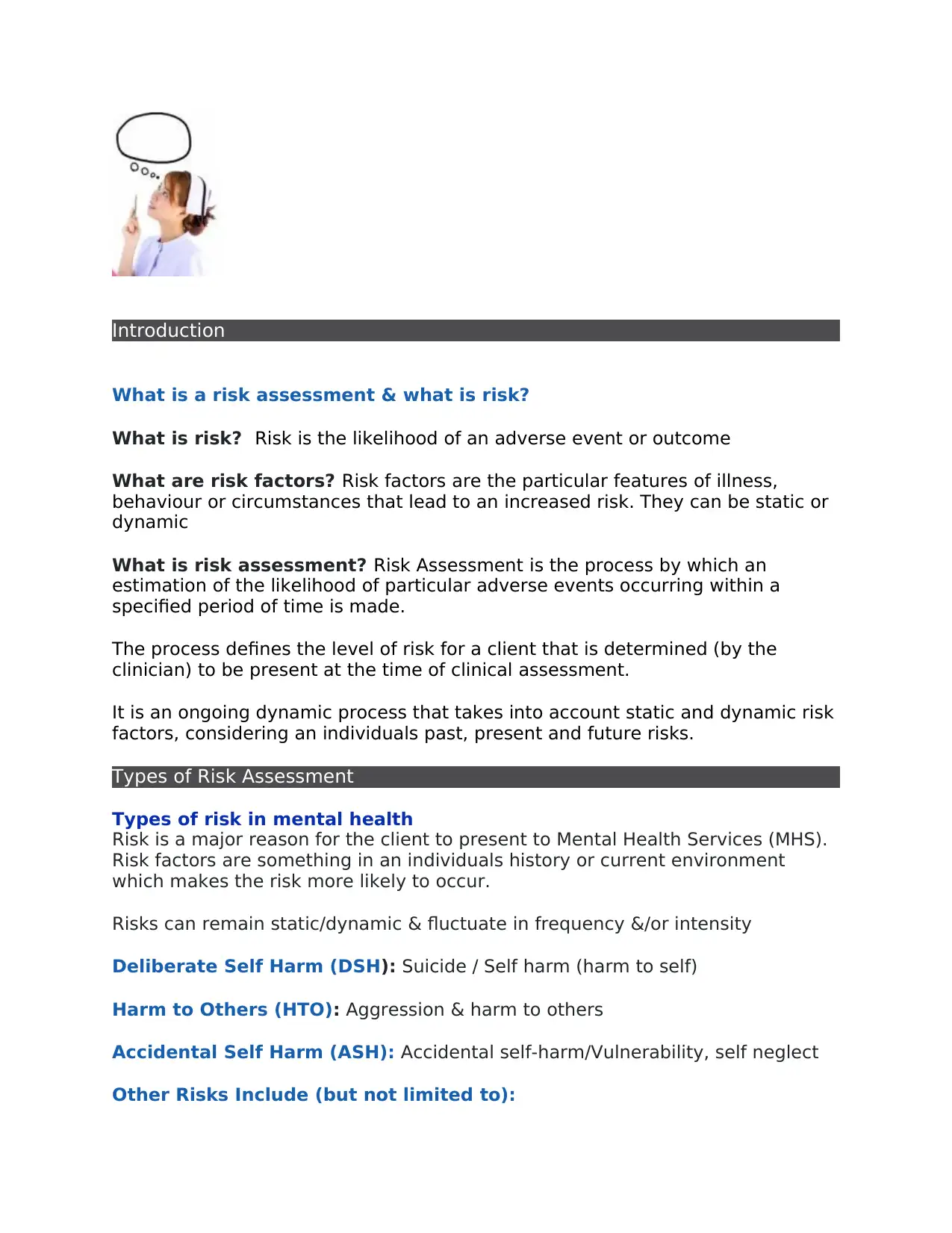
Introduction
What is a risk assessment & what is risk?
What is risk? Risk is the likelihood of an adverse event or outcome
What are risk factors? Risk factors are the particular features of illness,
behaviour or circumstances that lead to an increased risk. They can be static or
dynamic
What is risk assessment? Risk Assessment is the process by which an
estimation of the likelihood of particular adverse events occurring within a
specified period of time is made.
The process defines the level of risk for a client that is determined (by the
clinician) to be present at the time of clinical assessment.
It is an ongoing dynamic process that takes into account static and dynamic risk
factors, considering an individuals past, present and future risks.
Types of Risk Assessment
Types of risk in mental health
Risk is a major reason for the client to present to Mental Health Services (MHS).
Risk factors are something in an individuals history or current environment
which makes the risk more likely to occur.
Risks can remain static/dynamic & fluctuate in frequency &/or intensity
Deliberate Self Harm (DSH): Suicide / Self harm (harm to self)
Harm to Others (HTO): Aggression & harm to others
Accidental Self Harm (ASH): Accidental self-harm/Vulnerability, self neglect
Other Risks Include (but not limited to):
What is a risk assessment & what is risk?
What is risk? Risk is the likelihood of an adverse event or outcome
What are risk factors? Risk factors are the particular features of illness,
behaviour or circumstances that lead to an increased risk. They can be static or
dynamic
What is risk assessment? Risk Assessment is the process by which an
estimation of the likelihood of particular adverse events occurring within a
specified period of time is made.
The process defines the level of risk for a client that is determined (by the
clinician) to be present at the time of clinical assessment.
It is an ongoing dynamic process that takes into account static and dynamic risk
factors, considering an individuals past, present and future risks.
Types of Risk Assessment
Types of risk in mental health
Risk is a major reason for the client to present to Mental Health Services (MHS).
Risk factors are something in an individuals history or current environment
which makes the risk more likely to occur.
Risks can remain static/dynamic & fluctuate in frequency &/or intensity
Deliberate Self Harm (DSH): Suicide / Self harm (harm to self)
Harm to Others (HTO): Aggression & harm to others
Accidental Self Harm (ASH): Accidental self-harm/Vulnerability, self neglect
Other Risks Include (but not limited to):
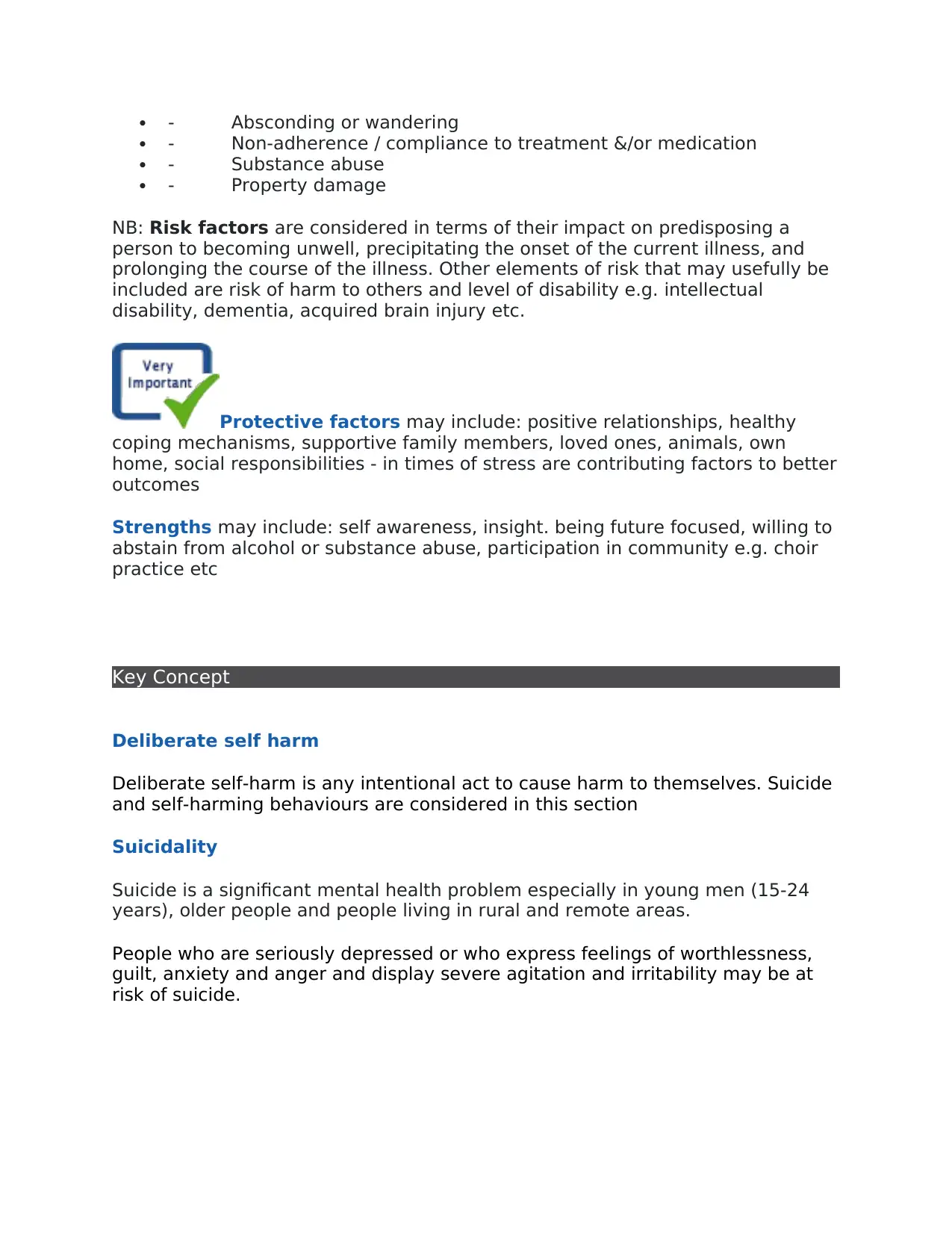
- Absconding or wandering
- Non-adherence / compliance to treatment &/or medication
- Substance abuse
- Property damage
NB: Risk factors are considered in terms of their impact on predisposing a
person to becoming unwell, precipitating the onset of the current illness, and
prolonging the course of the illness. Other elements of risk that may usefully be
included are risk of harm to others and level of disability e.g. intellectual
disability, dementia, acquired brain injury etc.
Protective factors may include: positive relationships, healthy
coping mechanisms, supportive family members, loved ones, animals, own
home, social responsibilities - in times of stress are contributing factors to better
outcomes
Strengths may include: self awareness, insight. being future focused, willing to
abstain from alcohol or substance abuse, participation in community e.g. choir
practice etc
Key Concept
Deliberate self harm
Deliberate self-harm is any intentional act to cause harm to themselves. Suicide
and self-harming behaviours are considered in this section
Suicidality
Suicide is a significant mental health problem especially in young men (15-24
years), older people and people living in rural and remote areas.
People who are seriously depressed or who express feelings of worthlessness,
guilt, anxiety and anger and display severe agitation and irritability may be at
risk of suicide.
- Non-adherence / compliance to treatment &/or medication
- Substance abuse
- Property damage
NB: Risk factors are considered in terms of their impact on predisposing a
person to becoming unwell, precipitating the onset of the current illness, and
prolonging the course of the illness. Other elements of risk that may usefully be
included are risk of harm to others and level of disability e.g. intellectual
disability, dementia, acquired brain injury etc.
Protective factors may include: positive relationships, healthy
coping mechanisms, supportive family members, loved ones, animals, own
home, social responsibilities - in times of stress are contributing factors to better
outcomes
Strengths may include: self awareness, insight. being future focused, willing to
abstain from alcohol or substance abuse, participation in community e.g. choir
practice etc
Key Concept
Deliberate self harm
Deliberate self-harm is any intentional act to cause harm to themselves. Suicide
and self-harming behaviours are considered in this section
Suicidality
Suicide is a significant mental health problem especially in young men (15-24
years), older people and people living in rural and remote areas.
People who are seriously depressed or who express feelings of worthlessness,
guilt, anxiety and anger and display severe agitation and irritability may be at
risk of suicide.
⊘ This is a preview!⊘
Do you want full access?
Subscribe today to unlock all pages.

Trusted by 1+ million students worldwide
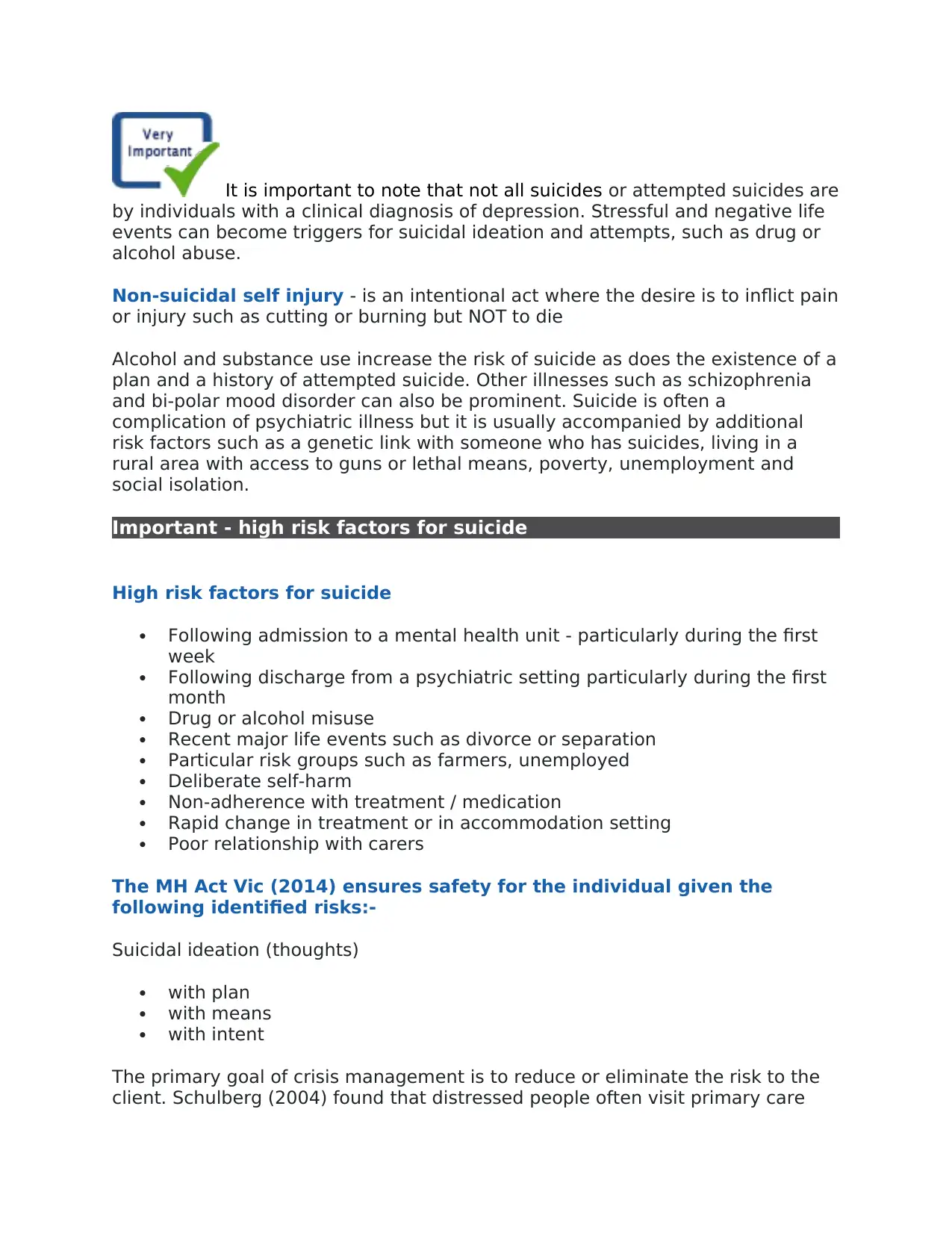
It is important to note that not all suicides or attempted suicides are
by individuals with a clinical diagnosis of depression. Stressful and negative life
events can become triggers for suicidal ideation and attempts, such as drug or
alcohol abuse.
Non-suicidal self injury - is an intentional act where the desire is to inflict pain
or injury such as cutting or burning but NOT to die
Alcohol and substance use increase the risk of suicide as does the existence of a
plan and a history of attempted suicide. Other illnesses such as schizophrenia
and bi-polar mood disorder can also be prominent. Suicide is often a
complication of psychiatric illness but it is usually accompanied by additional
risk factors such as a genetic link with someone who has suicides, living in a
rural area with access to guns or lethal means, poverty, unemployment and
social isolation.
Important - high risk factors for suicide
High risk factors for suicide
Following admission to a mental health unit - particularly during the first
week
Following discharge from a psychiatric setting particularly during the first
month
Drug or alcohol misuse
Recent major life events such as divorce or separation
Particular risk groups such as farmers, unemployed
Deliberate self-harm
Non-adherence with treatment / medication
Rapid change in treatment or in accommodation setting
Poor relationship with carers
The MH Act Vic (2014) ensures safety for the individual given the
following identified risks:-
Suicidal ideation (thoughts)
with plan
with means
with intent
The primary goal of crisis management is to reduce or eliminate the risk to the
client. Schulberg (2004) found that distressed people often visit primary care
by individuals with a clinical diagnosis of depression. Stressful and negative life
events can become triggers for suicidal ideation and attempts, such as drug or
alcohol abuse.
Non-suicidal self injury - is an intentional act where the desire is to inflict pain
or injury such as cutting or burning but NOT to die
Alcohol and substance use increase the risk of suicide as does the existence of a
plan and a history of attempted suicide. Other illnesses such as schizophrenia
and bi-polar mood disorder can also be prominent. Suicide is often a
complication of psychiatric illness but it is usually accompanied by additional
risk factors such as a genetic link with someone who has suicides, living in a
rural area with access to guns or lethal means, poverty, unemployment and
social isolation.
Important - high risk factors for suicide
High risk factors for suicide
Following admission to a mental health unit - particularly during the first
week
Following discharge from a psychiatric setting particularly during the first
month
Drug or alcohol misuse
Recent major life events such as divorce or separation
Particular risk groups such as farmers, unemployed
Deliberate self-harm
Non-adherence with treatment / medication
Rapid change in treatment or in accommodation setting
Poor relationship with carers
The MH Act Vic (2014) ensures safety for the individual given the
following identified risks:-
Suicidal ideation (thoughts)
with plan
with means
with intent
The primary goal of crisis management is to reduce or eliminate the risk to the
client. Schulberg (2004) found that distressed people often visit primary care
Paraphrase This Document
Need a fresh take? Get an instant paraphrase of this document with our AI Paraphraser
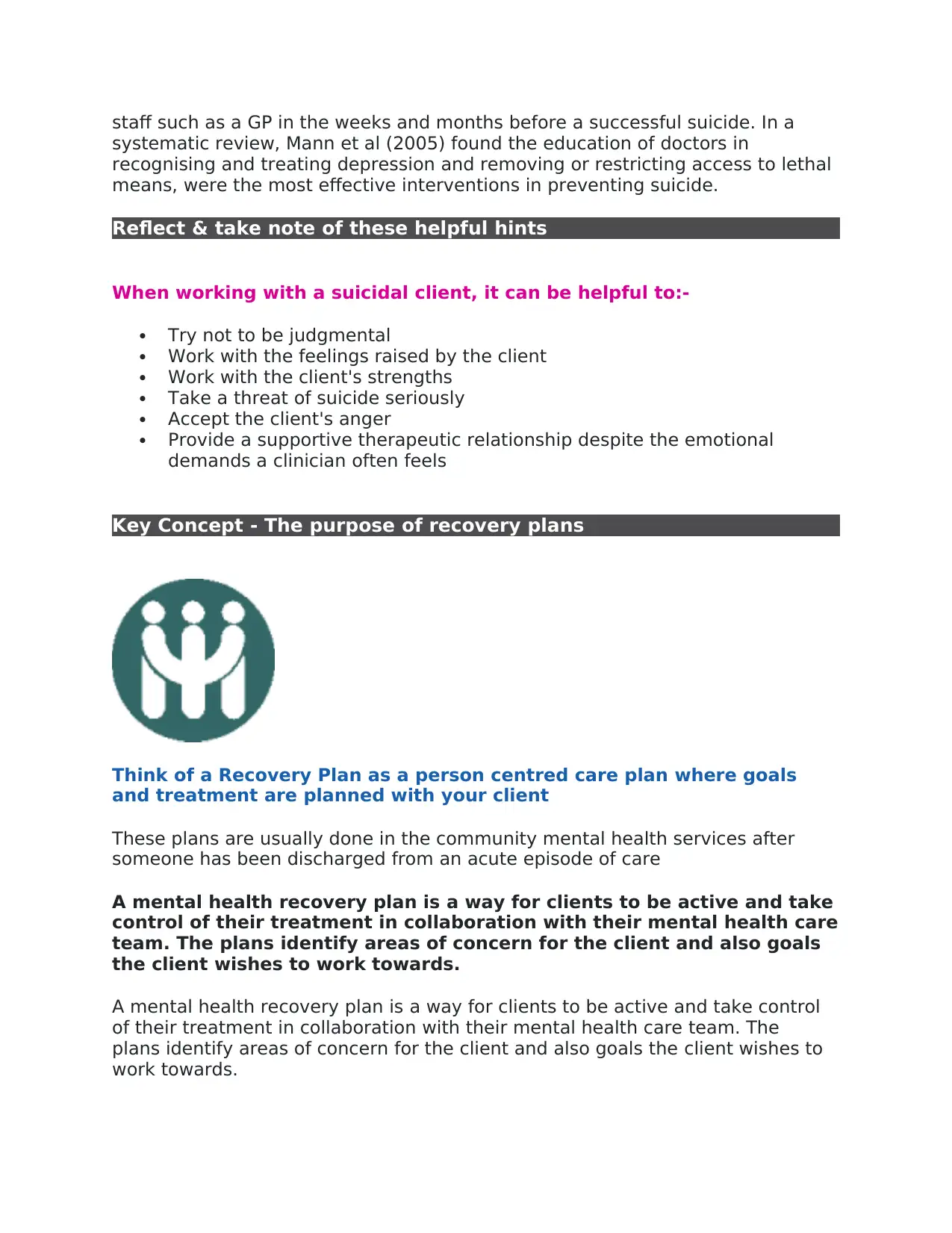
staff such as a GP in the weeks and months before a successful suicide. In a
systematic review, Mann et al (2005) found the education of doctors in
recognising and treating depression and removing or restricting access to lethal
means, were the most effective interventions in preventing suicide.
Reflect & take note of these helpful hints
When working with a suicidal client, it can be helpful to:-
Try not to be judgmental
Work with the feelings raised by the client
Work with the client's strengths
Take a threat of suicide seriously
Accept the client's anger
Provide a supportive therapeutic relationship despite the emotional
demands a clinician often feels
Key Concept - The purpose of recovery plans
Think of a Recovery Plan as a person centred care plan where goals
and treatment are planned with your client
These plans are usually done in the community mental health services after
someone has been discharged from an acute episode of care
A mental health recovery plan is a way for clients to be active and take
control of their treatment in collaboration with their mental health care
team. The plans identify areas of concern for the client and also goals
the client wishes to work towards.
A mental health recovery plan is a way for clients to be active and take control
of their treatment in collaboration with their mental health care team. The
plans identify areas of concern for the client and also goals the client wishes to
work towards.
systematic review, Mann et al (2005) found the education of doctors in
recognising and treating depression and removing or restricting access to lethal
means, were the most effective interventions in preventing suicide.
Reflect & take note of these helpful hints
When working with a suicidal client, it can be helpful to:-
Try not to be judgmental
Work with the feelings raised by the client
Work with the client's strengths
Take a threat of suicide seriously
Accept the client's anger
Provide a supportive therapeutic relationship despite the emotional
demands a clinician often feels
Key Concept - The purpose of recovery plans
Think of a Recovery Plan as a person centred care plan where goals
and treatment are planned with your client
These plans are usually done in the community mental health services after
someone has been discharged from an acute episode of care
A mental health recovery plan is a way for clients to be active and take
control of their treatment in collaboration with their mental health care
team. The plans identify areas of concern for the client and also goals
the client wishes to work towards.
A mental health recovery plan is a way for clients to be active and take control
of their treatment in collaboration with their mental health care team. The
plans identify areas of concern for the client and also goals the client wishes to
work towards.
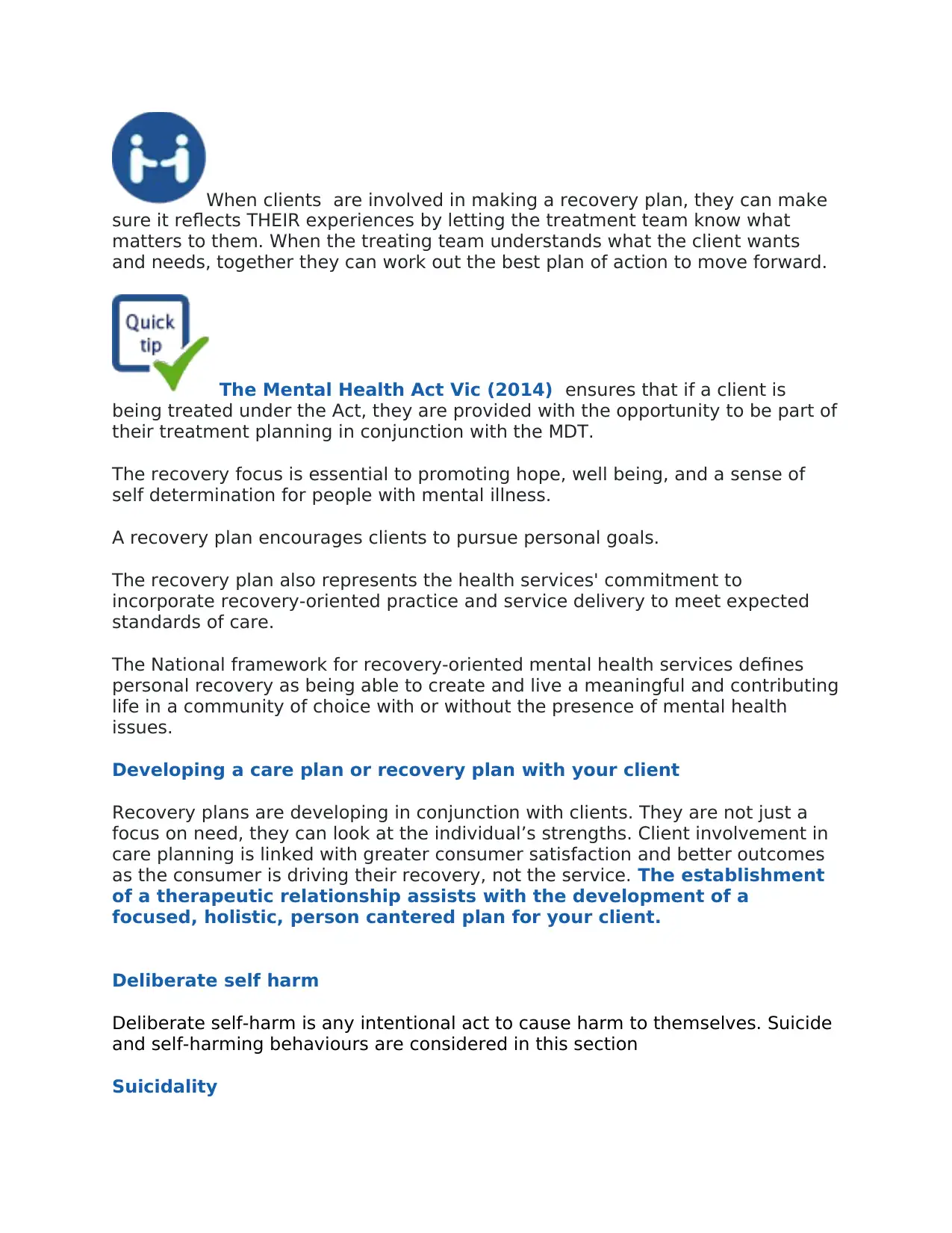
When clients are involved in making a recovery plan, they can make
sure it reflects THEIR experiences by letting the treatment team know what
matters to them. When the treating team understands what the client wants
and needs, together they can work out the best plan of action to move forward.
The Mental Health Act Vic (2014) ensures that if a client is
being treated under the Act, they are provided with the opportunity to be part of
their treatment planning in conjunction with the MDT.
The recovery focus is essential to promoting hope, well being, and a sense of
self determination for people with mental illness.
A recovery plan encourages clients to pursue personal goals.
The recovery plan also represents the health services' commitment to
incorporate recovery-oriented practice and service delivery to meet expected
standards of care.
The National framework for recovery-oriented mental health services defines
personal recovery as being able to create and live a meaningful and contributing
life in a community of choice with or without the presence of mental health
issues.
Developing a care plan or recovery plan with your client
Recovery plans are developing in conjunction with clients. They are not just a
focus on need, they can look at the individual’s strengths. Client involvement in
care planning is linked with greater consumer satisfaction and better outcomes
as the consumer is driving their recovery, not the service. The establishment
of a therapeutic relationship assists with the development of a
focused, holistic, person cantered plan for your client.
Deliberate self harm
Deliberate self-harm is any intentional act to cause harm to themselves. Suicide
and self-harming behaviours are considered in this section
Suicidality
sure it reflects THEIR experiences by letting the treatment team know what
matters to them. When the treating team understands what the client wants
and needs, together they can work out the best plan of action to move forward.
The Mental Health Act Vic (2014) ensures that if a client is
being treated under the Act, they are provided with the opportunity to be part of
their treatment planning in conjunction with the MDT.
The recovery focus is essential to promoting hope, well being, and a sense of
self determination for people with mental illness.
A recovery plan encourages clients to pursue personal goals.
The recovery plan also represents the health services' commitment to
incorporate recovery-oriented practice and service delivery to meet expected
standards of care.
The National framework for recovery-oriented mental health services defines
personal recovery as being able to create and live a meaningful and contributing
life in a community of choice with or without the presence of mental health
issues.
Developing a care plan or recovery plan with your client
Recovery plans are developing in conjunction with clients. They are not just a
focus on need, they can look at the individual’s strengths. Client involvement in
care planning is linked with greater consumer satisfaction and better outcomes
as the consumer is driving their recovery, not the service. The establishment
of a therapeutic relationship assists with the development of a
focused, holistic, person cantered plan for your client.
Deliberate self harm
Deliberate self-harm is any intentional act to cause harm to themselves. Suicide
and self-harming behaviours are considered in this section
Suicidality
⊘ This is a preview!⊘
Do you want full access?
Subscribe today to unlock all pages.

Trusted by 1+ million students worldwide
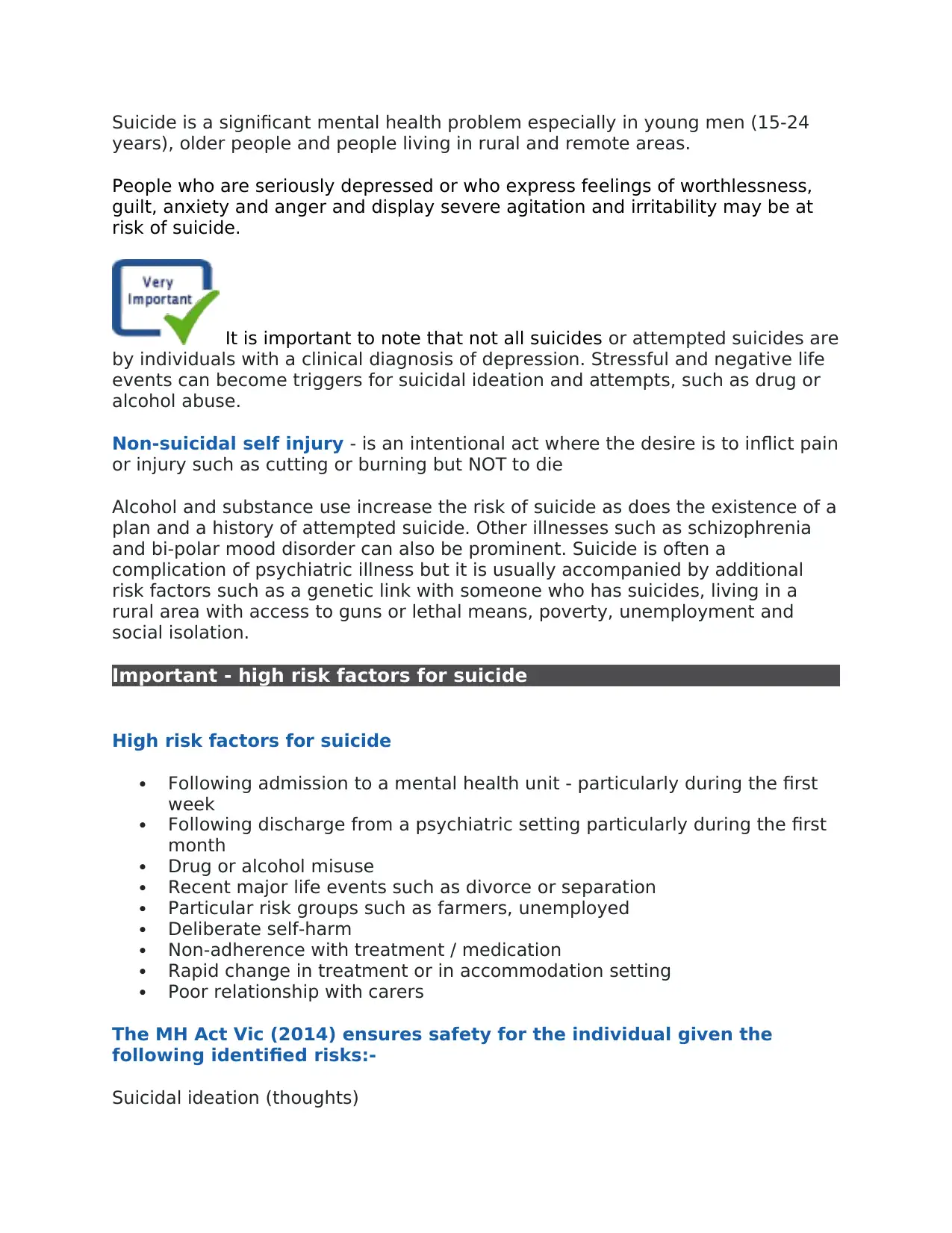
Suicide is a significant mental health problem especially in young men (15-24
years), older people and people living in rural and remote areas.
People who are seriously depressed or who express feelings of worthlessness,
guilt, anxiety and anger and display severe agitation and irritability may be at
risk of suicide.
It is important to note that not all suicides or attempted suicides are
by individuals with a clinical diagnosis of depression. Stressful and negative life
events can become triggers for suicidal ideation and attempts, such as drug or
alcohol abuse.
Non-suicidal self injury - is an intentional act where the desire is to inflict pain
or injury such as cutting or burning but NOT to die
Alcohol and substance use increase the risk of suicide as does the existence of a
plan and a history of attempted suicide. Other illnesses such as schizophrenia
and bi-polar mood disorder can also be prominent. Suicide is often a
complication of psychiatric illness but it is usually accompanied by additional
risk factors such as a genetic link with someone who has suicides, living in a
rural area with access to guns or lethal means, poverty, unemployment and
social isolation.
Important - high risk factors for suicide
High risk factors for suicide
Following admission to a mental health unit - particularly during the first
week
Following discharge from a psychiatric setting particularly during the first
month
Drug or alcohol misuse
Recent major life events such as divorce or separation
Particular risk groups such as farmers, unemployed
Deliberate self-harm
Non-adherence with treatment / medication
Rapid change in treatment or in accommodation setting
Poor relationship with carers
The MH Act Vic (2014) ensures safety for the individual given the
following identified risks:-
Suicidal ideation (thoughts)
years), older people and people living in rural and remote areas.
People who are seriously depressed or who express feelings of worthlessness,
guilt, anxiety and anger and display severe agitation and irritability may be at
risk of suicide.
It is important to note that not all suicides or attempted suicides are
by individuals with a clinical diagnosis of depression. Stressful and negative life
events can become triggers for suicidal ideation and attempts, such as drug or
alcohol abuse.
Non-suicidal self injury - is an intentional act where the desire is to inflict pain
or injury such as cutting or burning but NOT to die
Alcohol and substance use increase the risk of suicide as does the existence of a
plan and a history of attempted suicide. Other illnesses such as schizophrenia
and bi-polar mood disorder can also be prominent. Suicide is often a
complication of psychiatric illness but it is usually accompanied by additional
risk factors such as a genetic link with someone who has suicides, living in a
rural area with access to guns or lethal means, poverty, unemployment and
social isolation.
Important - high risk factors for suicide
High risk factors for suicide
Following admission to a mental health unit - particularly during the first
week
Following discharge from a psychiatric setting particularly during the first
month
Drug or alcohol misuse
Recent major life events such as divorce or separation
Particular risk groups such as farmers, unemployed
Deliberate self-harm
Non-adherence with treatment / medication
Rapid change in treatment or in accommodation setting
Poor relationship with carers
The MH Act Vic (2014) ensures safety for the individual given the
following identified risks:-
Suicidal ideation (thoughts)
Paraphrase This Document
Need a fresh take? Get an instant paraphrase of this document with our AI Paraphraser
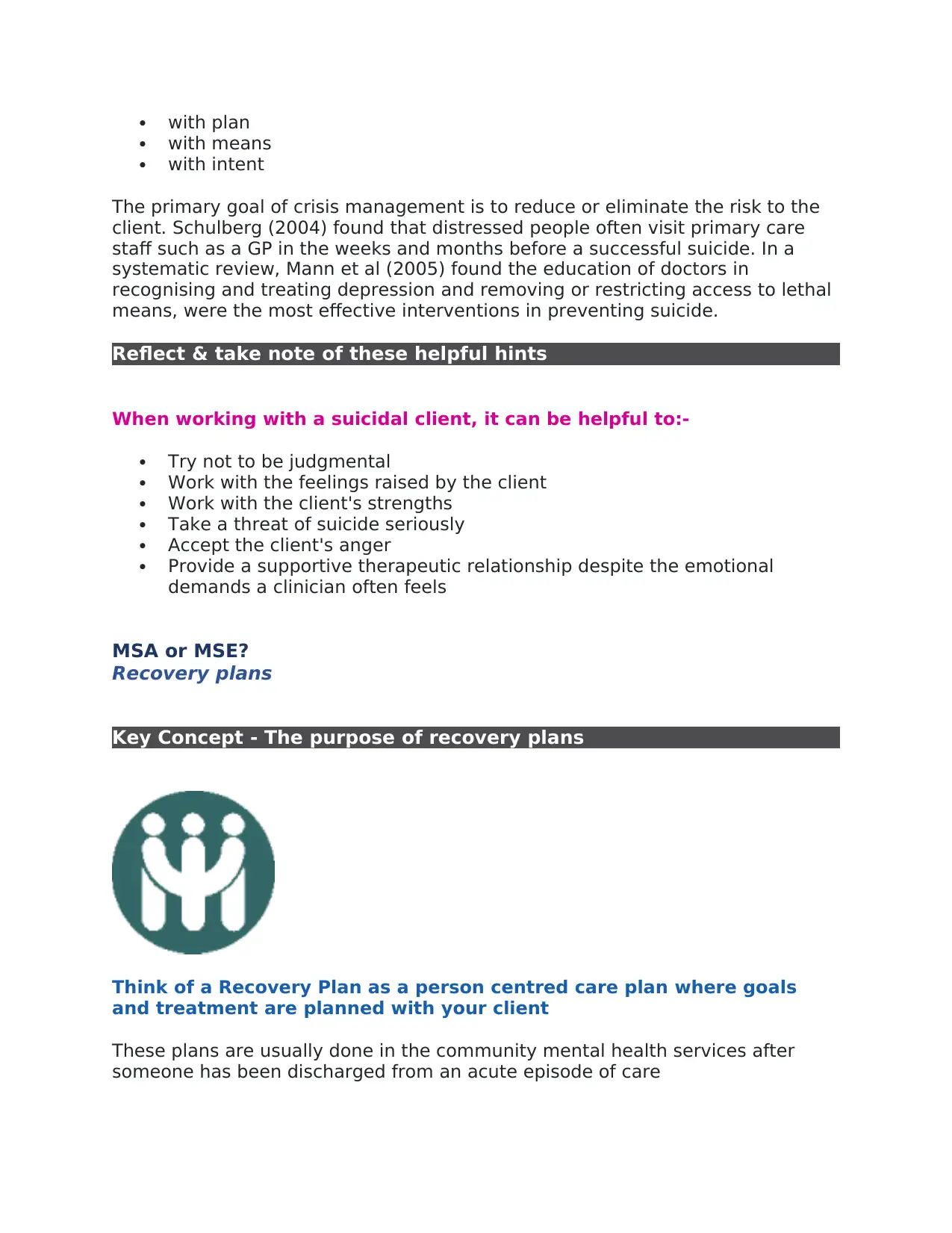
with plan
with means
with intent
The primary goal of crisis management is to reduce or eliminate the risk to the
client. Schulberg (2004) found that distressed people often visit primary care
staff such as a GP in the weeks and months before a successful suicide. In a
systematic review, Mann et al (2005) found the education of doctors in
recognising and treating depression and removing or restricting access to lethal
means, were the most effective interventions in preventing suicide.
Reflect & take note of these helpful hints
When working with a suicidal client, it can be helpful to:-
Try not to be judgmental
Work with the feelings raised by the client
Work with the client's strengths
Take a threat of suicide seriously
Accept the client's anger
Provide a supportive therapeutic relationship despite the emotional
demands a clinician often feels
MSA or MSE?
Recovery plans
Key Concept - The purpose of recovery plans
Think of a Recovery Plan as a person centred care plan where goals
and treatment are planned with your client
These plans are usually done in the community mental health services after
someone has been discharged from an acute episode of care
with means
with intent
The primary goal of crisis management is to reduce or eliminate the risk to the
client. Schulberg (2004) found that distressed people often visit primary care
staff such as a GP in the weeks and months before a successful suicide. In a
systematic review, Mann et al (2005) found the education of doctors in
recognising and treating depression and removing or restricting access to lethal
means, were the most effective interventions in preventing suicide.
Reflect & take note of these helpful hints
When working with a suicidal client, it can be helpful to:-
Try not to be judgmental
Work with the feelings raised by the client
Work with the client's strengths
Take a threat of suicide seriously
Accept the client's anger
Provide a supportive therapeutic relationship despite the emotional
demands a clinician often feels
MSA or MSE?
Recovery plans
Key Concept - The purpose of recovery plans
Think of a Recovery Plan as a person centred care plan where goals
and treatment are planned with your client
These plans are usually done in the community mental health services after
someone has been discharged from an acute episode of care
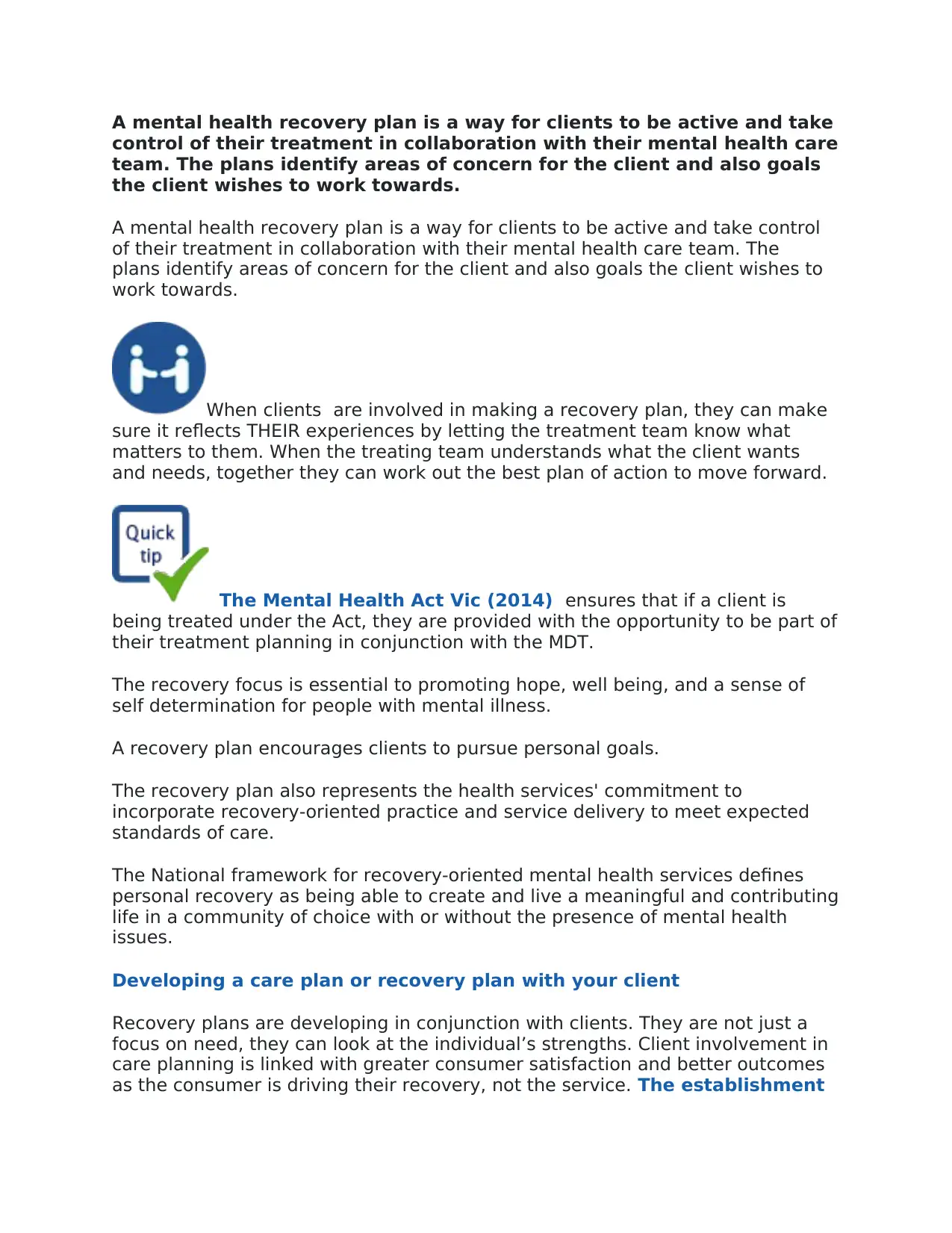
A mental health recovery plan is a way for clients to be active and take
control of their treatment in collaboration with their mental health care
team. The plans identify areas of concern for the client and also goals
the client wishes to work towards.
A mental health recovery plan is a way for clients to be active and take control
of their treatment in collaboration with their mental health care team. The
plans identify areas of concern for the client and also goals the client wishes to
work towards.
When clients are involved in making a recovery plan, they can make
sure it reflects THEIR experiences by letting the treatment team know what
matters to them. When the treating team understands what the client wants
and needs, together they can work out the best plan of action to move forward.
The Mental Health Act Vic (2014) ensures that if a client is
being treated under the Act, they are provided with the opportunity to be part of
their treatment planning in conjunction with the MDT.
The recovery focus is essential to promoting hope, well being, and a sense of
self determination for people with mental illness.
A recovery plan encourages clients to pursue personal goals.
The recovery plan also represents the health services' commitment to
incorporate recovery-oriented practice and service delivery to meet expected
standards of care.
The National framework for recovery-oriented mental health services defines
personal recovery as being able to create and live a meaningful and contributing
life in a community of choice with or without the presence of mental health
issues.
Developing a care plan or recovery plan with your client
Recovery plans are developing in conjunction with clients. They are not just a
focus on need, they can look at the individual’s strengths. Client involvement in
care planning is linked with greater consumer satisfaction and better outcomes
as the consumer is driving their recovery, not the service. The establishment
control of their treatment in collaboration with their mental health care
team. The plans identify areas of concern for the client and also goals
the client wishes to work towards.
A mental health recovery plan is a way for clients to be active and take control
of their treatment in collaboration with their mental health care team. The
plans identify areas of concern for the client and also goals the client wishes to
work towards.
When clients are involved in making a recovery plan, they can make
sure it reflects THEIR experiences by letting the treatment team know what
matters to them. When the treating team understands what the client wants
and needs, together they can work out the best plan of action to move forward.
The Mental Health Act Vic (2014) ensures that if a client is
being treated under the Act, they are provided with the opportunity to be part of
their treatment planning in conjunction with the MDT.
The recovery focus is essential to promoting hope, well being, and a sense of
self determination for people with mental illness.
A recovery plan encourages clients to pursue personal goals.
The recovery plan also represents the health services' commitment to
incorporate recovery-oriented practice and service delivery to meet expected
standards of care.
The National framework for recovery-oriented mental health services defines
personal recovery as being able to create and live a meaningful and contributing
life in a community of choice with or without the presence of mental health
issues.
Developing a care plan or recovery plan with your client
Recovery plans are developing in conjunction with clients. They are not just a
focus on need, they can look at the individual’s strengths. Client involvement in
care planning is linked with greater consumer satisfaction and better outcomes
as the consumer is driving their recovery, not the service. The establishment
⊘ This is a preview!⊘
Do you want full access?
Subscribe today to unlock all pages.

Trusted by 1+ million students worldwide
1 out of 31
Related Documents
Your All-in-One AI-Powered Toolkit for Academic Success.
+13062052269
info@desklib.com
Available 24*7 on WhatsApp / Email
![[object Object]](/_next/static/media/star-bottom.7253800d.svg)
Unlock your academic potential
Copyright © 2020–2025 A2Z Services. All Rights Reserved. Developed and managed by ZUCOL.





